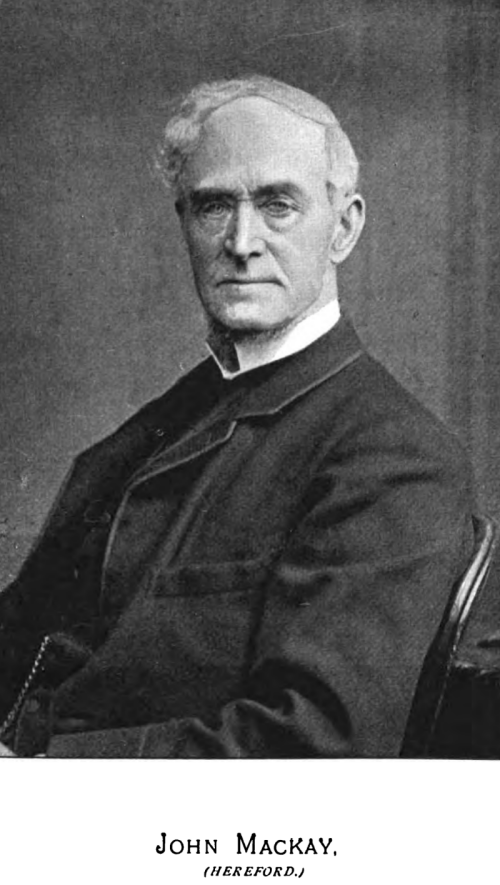|

THERE could be no better plea
for the Preservation of a Highland peasantry than the existence of such
families as the one to which the subject of this sketch belongs. Mr. John
Mackay, of Hereford, is a native of Rogart, Sutherland, and is the third
member of a family of seven sons and two daughters, eight of whom still
survive, and are in good positions. His father and grandfather were both
Johns, and locally known as the “M’Neills,” pointing to their honourable
Abrach descent. His mother, Margaret Sutherland, was an ideal housewife;
“she was not afraid of the snow for her household,” as they were all clad,
if not in "scarlet,” at anyrate in beautifully-made Mackay tartan, she being
an expert in spinning and dyeing wool. His father was a quiet, shrewd man,
who at the age of 17 enlisted into the 42nd Highlanders in 1810, and retired
from that noble regiment upon its return from France in 1818; at the
Disruption he became an elder of the Free Church. He was the proud possessor
of the first “white house” in the upper part of the parish of Rogart.
Under such home influences “Johnny Achail-leach” — for so he was
distinguished, from the name of the croft — developed into a bright,
generous boy, and very early gave promise of those kindly traits of
character so well known in the “Hereford” of to-day. He was educated
entirely in his native parish — first under Mr. Gunn, who dared to encourage
the banned Gaelic even in school hours, and afterwards under Mr. Fraser,
whose scholars were specially noted for excellent penmanship, a striking
feature of Mr Mackay’s correspondence still. Being naturally clever, he
received a fair share of his teacher’s attention (for Mr. Fraser had no
inclination to waste time over dunces), and in addition to English and
mathematics, was taught Latin and Greek.
Prompted by those natural impulses which are so essential to success in the
emigrant, he resolved at the age of nineteen to try his fortunes in the
south, knowing that by improving his own position he would be the better
able to benefit others. That period, now nearly fifty years ago, was the
time of the great railway “boom,” and the young Highlander sought work in
their construction. Tall, strong, and athletic, with quite a military
bearing, had he not found at once congenial employment in the industrial
army, he would probably have become a soldier, so fond was he of the heroic
and martial achievementsof his countrymen as his forefathers were. Familiar
with manual labour, and accustomed to handle horses, he was offered and
accepted employment as the driver of a team, but was soon advanced to
timekeeper, and then, coming more immediately under the notice of his
employer, his abilities were recognised, and promotion was rapid. At
twenty-four years of age he was made superintendent of a section of the
Dieppe line, and remained in France during part of the trying time of the
Revolution of ’48. During this period he acquired great proficiency in the
French language, his thorough knowledge of Gaelic being very helpful to him.
Returning to England in 1848, he found work on the Great Northern Railway,
and the famous railway king — Mr. Brassey — gave him, young as he was, a
portion of the line to construct as a contractor. Then followed the
Shrewsbury and Hereford Railway, the Sambre and Meuse Railway, and other
extensive engineering works at home and abroad, in all of which he earned a
well-merited reputation for skill in carrying out arduous undertakings and
in dealing with men.
Arrived at middle life, his warm heart yearned to be more helpful to his
fellows in the Highlands and elsewhere, and amidst the toil and cares
incident to a large business he still found time to consider carefully any
patriotic scheme submitted to him. None know this better than the people of
his native county, where his munificence has been princely.
His intelligent sympathy with the Highland land movement is well known, and
many a long journey he made to take part in meetings on the subject, some of
his addresses being afterwards printed. In 1883 he gave valuable evidence
before the Napier Crofters’ Commission on the land question; in subsequent
years he communicated interesting papers to the Gaelic Society of Inverness
on the “Place-names of Sutherland (vide “Transactions”); and he also
rendered into English many of Rob Donn’s poems. Recently he published a neat
little volume on the “Reay Fencibles;” reprinted the thrilling story, “The
Wreck of the Juno,” by Captain William Mackay; and also reprinted the
“History of the Highland Society of London.” He is a Justice of the Peace
for Herefordshire, an Associate of the Institute of Civil Engineers,
ex-president of the Clan Mackay Society (the formation of which was largely
due to his enthusiasm), and a member of a host of other patriotic
associations in Scotland, England, and Wales.
Mr. Mackay has been appropriately styled a true Highlander, and one of
Nature’s noblemen. Long may we have him in our midst as a bright incentive
for others to follow his lofty example.
D. W. Kemp. |

